Don't wanna be here? Send us removal request.
Text
Assignment 3 - Week 4 (Final Edits , Part 2)
Section B
Part 2
The piano and the beats were eqed in contrasting frequencies, while Gain was used on the rain sound to make it sound more prominent.


Section C
Part 1
As for the movie dialogue, I used reverb for the main loop, while also applying pitch shifter to the double loop. I also used compressor on the drums to make them sound richer and more prominent as originally it sounded a bit too weak. I also increased the eq on the lower frequencies.
As for the guitar, I decreased the eq on the lower frequencies (to contrast the drums) and then increased the higher frequencies to add more brightness.

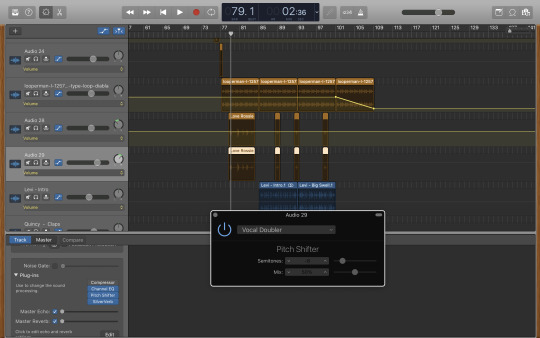

Section D
Part 1
I used compressor on the rain and thunder sound to make it more prominent. Reverb was also used on the tick-tock sound to make it more dramatic and representative of time passing by. The shaker was also weak sounding, so I had to use some compression on it.

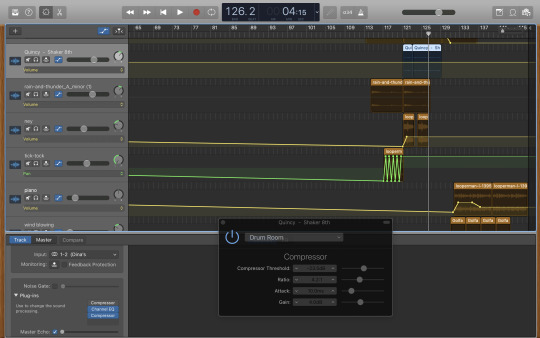

Part 2
Lastly, I applied compressor on the Duduk loop to make it sound more prominent. In general, this is a weak sounding instrument, but given its dark and depressing sounding melody, I wanted to make it sound more prominent compared to the piano.
Using EQ, I also decreased the lower frequencies on the piano to make it sound less bright given that this section is describing a post-death grief.


0 notes
Text
Assignment 3 - Week 4 (Final Edits , Part 1)
I spent the last few remaining days on editing my piece, meaning using plugins such as eq, reverb, compression, echo, etc., as well as editing the level of volume in different parts and doing the final mix. Writing a detailed journal of all these, given the length of the track and the variety of loops used, will be lengthy and exhausting to read, so, I have written a summary of the most important edits I have made here.
Section A
Part 1
The Kamanche loop in the intro was eqed to remove some of the more unpleasant frequencies. As a string instrument, Kamanche might sound a bit too heavy at times, especially when you are hearing it for the first time. That is why eq was particularly helpful in making it sound a bit milder. The recording quality of the loop wasn't quite high, so eq was used to remove some of the noises in the sound (photo 1).

The drums loop was eqed to emphasise the lower frequencies, as well as being compressed to make it sound richer and heavier (photo 2).
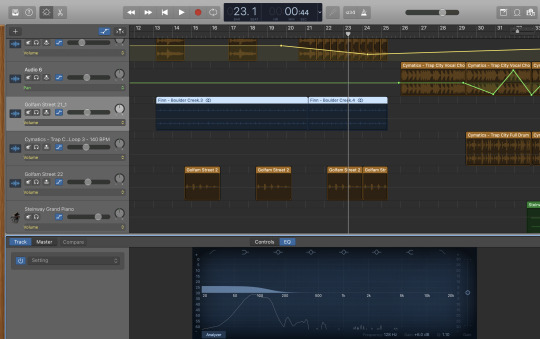
Eq was also used on the heavy breathing loop to remove some of the unexpected noises as it was recorded with a low-quality microphone. I then used reverb on it to make it sound more dramatic and attention-grabbing (photo 3 and 4).
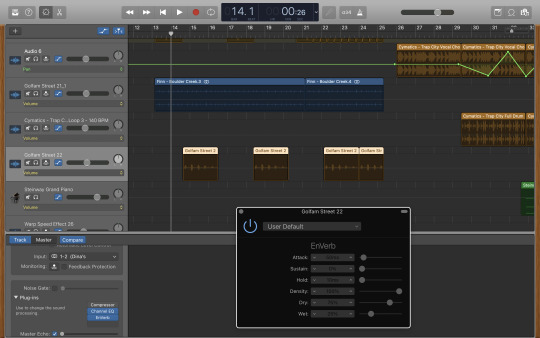

Part 2
The drums and the trap vocals were eqed in the opposite frequencies (drums in the lower frequencies and vocals in the higher frequencies, photos 5 and 6)
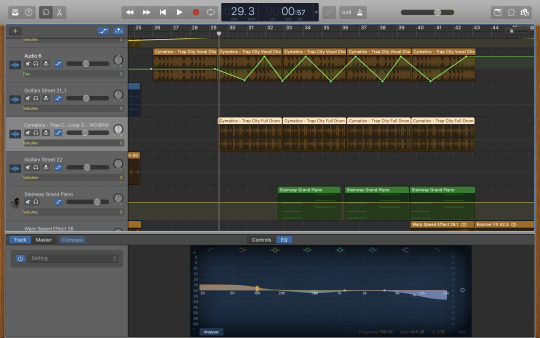

Section B
Part 1
Both laughs were eqed to remove noises in the loop. I then used reverb on them to contrast them with the rest of the sounds being played.
I also used reverb on the movie line along with Gain, to grab more attention. The last bit of the dialogue ("what have you") was echoed to give it a more contrasting and dramatic finish.
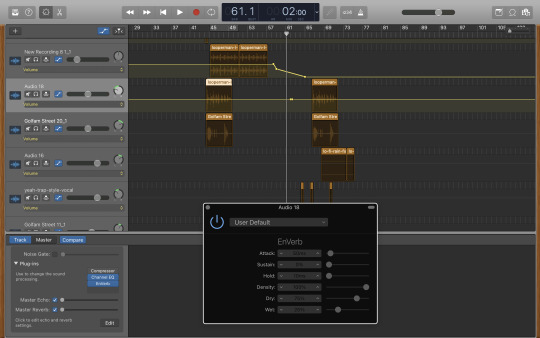
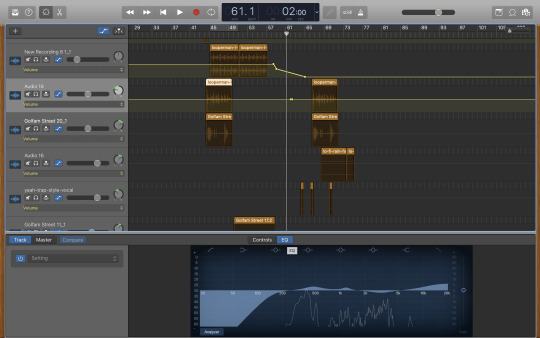
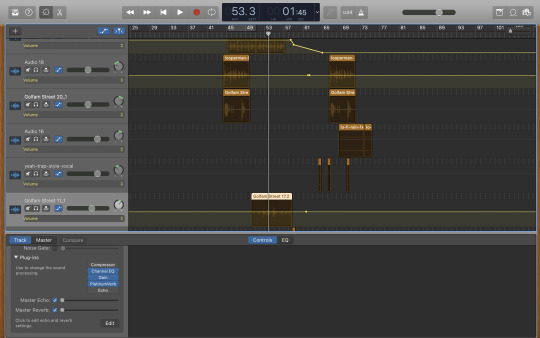
0 notes
Text
Assignment 3 - Week 4 (Section D)
Section D describes the chapter of the story after Shahmaran's death. Part 1 depicts the graveyard with Camsab sitting next to Shahmaran's grave and grieving for her death. There is a heavy rain and thunder in the background, conveying a sense of darkness and sadness and the tick-tock sound implies the passing of time and the fact that Camsab has sat there for days grieving. There is also a gloomy sounding Ney loop (a folk instrument that is played in the region) in the background. You can see the screenshot for this part here.

The second part of section D (and last part of the track) depicts a big open field where Camsab is walking and realises the fact that Shahmaran's death happened to save the lives of others, giving it sort of an epic and emotional ending. You can hear the sound of the wind blowing in the background and at the start of the scene, there is a line from the movie Mulholland Falls, explaining how the sacrifice of some people can save the lives of the others. There is also a Duduk loop (another folk instrument from the region) being played in the background. Here is a screenshot of this section after completion.

Section D has a slow tempo and is quite heavy and depressing, so I had to slow down the tempo of the track as you can see in the next photo.

0 notes
Text
Assignment 3 - Week 4 (Section C)
Section C is what they call the honeymoon period of the storyline, when the two main characters fall in love with each other and everything is just superfantastic. So, I decided to use a soft-sounding acoustic guitar loop as the main melody here. Additionally, I used a line from the movie 'Love Rosie' in this section ("I will always, honestly, truly, completely, love you") as it sounded relevant to what I was trying to depict here. The following screenshot shows part 1 of section C after it was finished. As you can see, I have also used the doubling technique on the movie line. Panned to the left ear, is the normal sounding dialogue from the movie, while the thicker double version is being played from the right ear. There were two reasons for doing this: 1. her voice sounded a lot more richer this way, grabbing the attention of the listener. 2. after all, Shahmaran, the leading female character, is a half-snake creature, so, using the doubling technique this way gave it a monstrous and scary sense.

At first, instead of the movie dialogue, I tried to sing and record a simple 'eh-oh' line by myself. But my voice is just far from being nice to hear and even after using all the plugins at hand (eg eq, reverb, pitch shifter, etc.) is still sounded terrible. So, I switched to Love Rosie instead. You can see a screenshot of my unsuccessful attempt here.
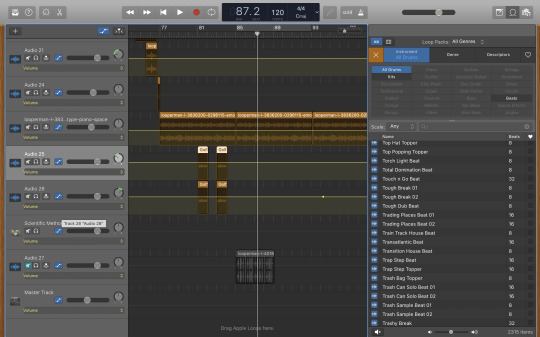
As part of yet another unsuccessful attempt, I tried to use an emotional (improv) chord progression on piano as the main melody line for this part, but I replaced it with another loop later (which you can hear in the final piece as well) because it sounded better with other audio elements in this section, particularly the laughing recordings. You can see a screenshot of this here.

As for part 2 of section C, this is where Shahmaran accepts to sacrifice herself to save the king of the city. Now in the original tale there is not much detail about why she does that so I had to get creative here and use my imagination. So, in my storyline, the reason why she accepts death to save the king is because the people of the city have become aware of Shahmaran's healing abilities and her love for Camsab, so they have taken Camsab hostage and the only way for her to save him is to heal the king, which according to the tale is only possible when he kills and eats Shahmaran's flesh (I know, sounds a tat bit dramatic!).
So for this section, I used a dramatic sounding violin loop as well as a recording of a crowd of people. There is also a recording of a woman crying, depicting the difficulty of the situation for the main characters of our story. Lastly, I re-used the heavy breathing sound from section A to convey that sense of fear and excitement. You can see a screenshot of section C's part 2 here.

0 notes
Text
Assignment 3 - Week 3 (Refinement of Sections A and B)
After getting my first feedback, I decided to do a major refinement in sections A and B. As for section A, I changed the main melody as well as the beats as they sounded a bit too intense. To further soften the tone of my music and make it relatable for the audience, I recorded a simple chord progression on piano.
Using the second feedback I got, I also realised that despite establishing the general atmosphere for each section, I needed to get into way more details about what exactly each section is describing; in other words, just like a movie, I decided to come up with a proper storyline so that I could narrow down the specific audio elements and sources that I needed more easily.
This change in the creative process was helpful and the task of composition and coming up with new ideas was constantly made easier. At the same time, to maintain that sense of continuity and some elements of surprise in my piece, I decided to make this a more spontaneous process, so instead of narrowing down the details of each section at the start, I did this while composing. With such a flexible approach, it was easier for me to analyse and change the structure of piece as I was not committing to a specific plan.
To this, I usually sat down and imagined the specific elements of the movie and storyline in my mind (of course based on the original tale) and then made my music. For instance, part 1 of section A is when the main character (Camsab) enters the (scary and dark) cave and has no idea what is waiting for him on the other side. To make things more dramatic, I recorded myself breathing heavily and then added it to this part to convey a sense of fear. Part 2 is in trap style and happens when he reaches 'the other side' and sees a city of half snake half human creatures inside the cave. You can see the screenshot of section A after these edits.
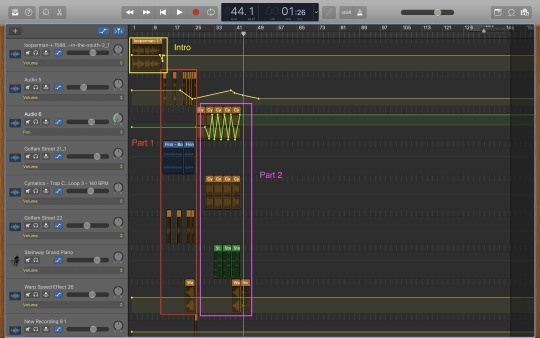
I decided to completely scrap everything I had composed for section B and start from scratch. Using the creative process described above, I came up with two separate parts for section B: 1. the two main characters (Shahmaran and Camsab) start getting closer to each other by putting aside their differences and seeing the beauty in their relationship. I used male and female laughing sounds panned between the left and the right ear as well as a line from the movie 'Juno' that I think best describes this concept of oneness and setting aside the differences. 2. the second part depicts a dance between the two characters that makes their relationship even more intimate, opening the way for the third section, which is when they fall in love. I tried to make this somewhat a lo-fi bit that conveys feelings of mystery as this is supposed to be a mystical dance under the rain. The first photo here shows part 1 and the second one shows part 2.

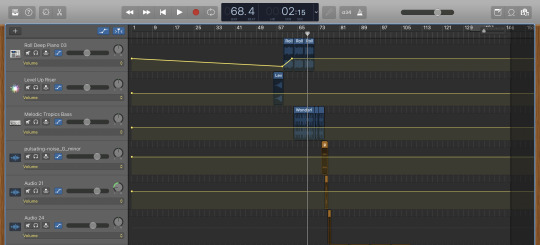
Unsuccessful Attempts:
Inspired by Niall's lecture notes and more particularly, Pogo's Gardyn track, at first I decided to make my own beat for part 2 of section B, using sound sources that one could have heard in a cave in the past (eg stone flicking, hand rubbing for example, for starting a fire, etc.). You can see a screenshot of my attempt here. I created these sounds using simple methods, for instance, by rubbing my hands together, or hitting two stones together.
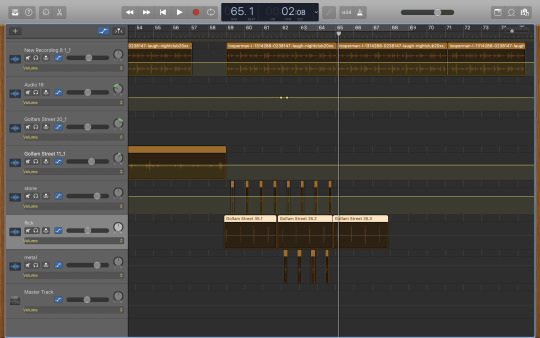
The process, however, seemed a bit too complicated given the structure of the piece and using a pre-made beat seemed like a more practical option. One reason perhaps could be the lack of high-quality recording tools.
2. I had also recorded an emotional chord progression on piano as my main melody for section B part 1 (as you can see in the following photo), but after trying it out a couple of times, I decided to replace it with another melody line (which is what you can hear in the final track as well) as this one sounded better with other audio elements in that specific section, for example with the laughing sounds in particular.
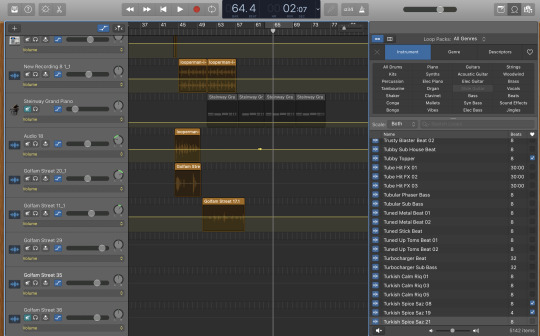
Last but not least, Luke's lecture notes were particularly helpful throughout the course of the composition for me. When doing assignment 1, given my limited experience in digital music production and my limited tools, I didn't get very creative and mostly stuck with pre-made loops (leading me to even change my artistic vision a couple times). This time, however, applying Luke's tips on keeping things simple, using simple tools such as my phone's microphone, and making music decisions that I like, I was less limited by these factors at least in my mind, leading me to record a lot of the loops (mostly non-musical ones) with my phone's microphone, for example. Of course having better tools or more experience would have improved my track, but I was happy with the output of my efforts and, more importantly, with the fact that I had followed what I liked to do it both in terms of composition and artistic vision.
0 notes
Text
Assignment 3-Week 2 (Sections A & B)
I decided not to stick to a particular genre as each section is describing a different part of the story. As for section A, I chose to go with trap because it could best represent that particular atmospheric sense that I was after, especially given the variety of beats used in it.
I was not very familiar with how trap music is produced, although I do listen to it quite often. So, I watched this Youtube tutorial here to get myself familiar with the whole process. Thankfully, it helped me find a variety of different trap loops, which you can find here. I was also able to download pre-made loops of West Asian folk instruments via Looperman (after spending A LOT of time searching!). The particular loop that I decided to use, which you can hear in the opening for section A, is made by an instrument called Kamanche.
The following photo shows a screenshot of section A after its completion. You can probably guess that Niall's lecture on combining musical and non-musical sound sources was particularly useful given my artistic vision. I used some dialogues from the first Dr Strange movie as it was about healing and otherwordly entities and therefore relevant to our folk tale. Lastly, I created a constant panning between the left and the right ear in the foreground for this section to represent the zigzag movement of snakes.

As for section B, I decided to combine some pre-made loops on Garageband with some improvs that I made on Santur, another folk instrument from the region. You can see section B after completion in the following photo. I was not entirely happy with the outcome of my work particularly for this section because it was not really conveying the feelings that I wanted to the audience. It also sounded a bit too flat.

I wanted my piece to depict different parts of the same story (similar to a movie), hence, I needed to create a sense of continuity between the different sections of my piece (refer to the previous post). That is why I decided to use a 'cha-ching' sound whenever there is a change of sections to imitate the passing of time and the start of a new chapter in the story.
I also had some ideas for section C at this stage, which were mostly inspired by Kygo's new single, Freeze. But I decided not to continue composing since I wanted to refine sections A and B first.
You can hear my final draft at the end of this week on Canvas (the discussion board for Wed 10 am) here.
0 notes
Text
Assignment 3-Week 1 (Artistic Vision)

I wanted to explore option 4 of the assignment (ie devising my own project) and for this, having a sound artistic vision was an essential first step. I have always been interested in the fusion between folk and modern music and also in narrative and film music composition. That is why I decided to find a famous folk tale and then use its story as my artistic vision. I even tried to explore this in my first assignment, but with my level of experience in digital music production at that time, such an artistic vision seemed like a challenging and impractical choice.
This time, however, I was desperate to make my idea work and for that, I needed to choose the folk tale that I wanted to focus on. I decided to use a story from West Asia since I was already familiar with the literature and folk music of the region to a good extent. After an extensive research, I finally chose to use the Shāhmārān story (Persian, meaning the king of the snakes) which is a famous tale in Iran, Turkey, and the Kurdish communities. I strongly suggest you read the summary of the story here first to better understand some of my creative choices through this production journey.
The last thing that I wanted to do this week was to organise my piece into different sections as this was going to be a narrative piece. You can see the structure that I came up with based on the story in the photo uploaded here. Now it was time to actually start composing.
1 note
·
View note